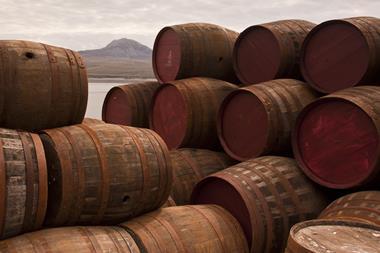Analytical chemists pick out aromas key to whiskey's flavour
Researchers based in Germany have picked out the molecules responsible for the aroma of Kentucky bourbon, in order to understand - and perhaps control - the spirit’s flavour.
Such is the diversity of whisky - from the smoky Scottish variants to the vanilla tasting American versions - that even after forty years of research, its flavour chemistry is still not fully understood. Over 350 volatile compounds have already been discovered in whisky. But, as with other food and drink, only a fraction of these molecules can actually be smelt by the human nose, so contributing to the spirit’s aroma; the others have no interaction with human olfactory receptors, says Peter Schieberle of the Technical University in Munich. Only a few studies have focused on the key aromas so far, he adds.
Schieberle’s group have now isolated those aroma components in an American bourbon which are key to its flavour. They combined gas chromatography and mass spectrometry to identify volatile compounds extracted from the vanilla-tasting spirit, and used human sniffers to link each compound to its smell. The team ranked the volatiles according to their odour-potency - and as extraction can lead to the loss of volatiles, the air directly above the whisky fractions was also analysed, yielding further compounds important to the aroma of bourbon. In total, the researchers picked out 45 compounds that it’s possible to smell, 13 of these not identified before. The most potent aromas included fruit, malt, flower, coconut, vanilla, and cooked apples.
Rather than distilling the whisky directly to obtain volatile compounds, the researchers diluted the drink with water, which allowed them to separate out ethanol from other volatile compounds that were subsequently extracted in ether. The resulting solution was then concentrated before being carefully distilled under high vacuum - a so-called ’solvent assisted flavour extraction’, which the group developed some years ago in order to pick out aroma compounds from foods.
’To be able to isolate the aroma from the forty percent ethanol is quite a coup as ethanol itself is a volatile substance,’ says Andy Taylor, a professor of flavour technology at Nottingham University, UK. ’This sort of thing has been done before for ordinary food such as yoghurts but not for whisky.’
Schieberle says that now his team has identified bourbon’s aroma blueprint, they are following all 45 compounds through the whisky making process. Some of the desirable flavour compounds, they find, are degraded as the bourbon is produced - so they are hoping to work out whether the processing can be changed to save them.
Despite this step forward in understanding whisky’s flavour chemistry, the drink still has an air of mystery. ’You cannot formulate whisky,’ says Frances Jack, of The Scotch Whisky Research Institute. ’This research does not allow us to easily change the taste of whiskies but it does represent a small step towards understanding more about this complex spirit.’
Ruth Tunnell
Enjoy this story? Spread the word using the ’tools’ menu on the left.
References
J.Agric. Food.Chem.,56, 5813-5819. DOI: 10.1021/jf800382m







No comments yet